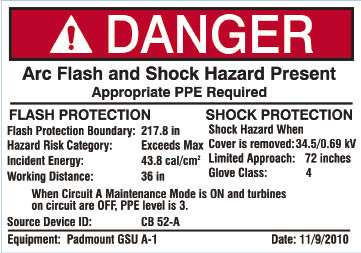Dan O’Connor, Tech Products, www.techproducts.com
 Earlier this year, the National Fire Protection Association issued an update to its Standard 70E. The NFPA’s Committee on Electrical Safety in the Workplace has responsibility for this standard. Its Article 130 will be of most interest to wind farm electrical crews because it adds detail to the hazard of arc flash.
Earlier this year, the National Fire Protection Association issued an update to its Standard 70E. The NFPA’s Committee on Electrical Safety in the Workplace has responsibility for this standard. Its Article 130 will be of most interest to wind farm electrical crews because it adds detail to the hazard of arc flash.
An arc flash occurs when fault current, many thousands of amps – such as in a wind farm power transformer – flows across an air gap and creates highly ionized gas. The flash can generate high temperatures that heat air fast enough to seem like

The labels have been designed to client requests and manufactured by Tech Products. The labels show some variation allowed by Article 130, Part 1) of Sect 130.3 (C) in the recent NFPA Standard 70E. A wide variety of other variations are possible.
an explosion and powerful enough injure workers. A previous article in this magazine (http://tinyurl.com/7ewyrdg) details more of the hazard. For conciseness, consider it a potentially lethal event.
The first significant change to the standard is that the word “protection” has been removed from the phrase “arc flash protection boundary”. To be clear, this does not mean staying “outside the boundary” eliminates possible injury. Outside the boundary only limits possible injury.
Another point of discussion is obvious in practice but has not been specified. Now the standard says that workers must wear Personal Protective Equipment (PPE) when any arc-flash potential exists, and not just when an analysis for it has been made.
The labeling requirements detailed in NFPA standard 70E Sect 130.3 (C) have been changed to this: “Electrical equipment such as switchboards, panelboards, industrial control panels, meter socket enclosures and motor control centers that are in other than dwelling units and are likely to require examination, adjustment, servicing or maintenance while energized shall be field marked with a label containing all the following three pieces of information:
1) At least one of the following:
a) Available incident energy and the corresponding working distance
b) Minimum arc rating of clothing
c) Required level of PPE
d) Highest Hazard Risk Category for the equipment
2) Nominal system voltage, and
3) Arc-flash boundary.
At least Part 1 of Sect 130.3 (C) gives equipment manufacturers several options.
Still, for the uninitiated, the recent NFPA Standard 70E can be daunting. However, more professional label manufacturers are well versed in the standard’s details and can guide the design of an arc flash warning label. WPE
Filed Under: News, Safety





A clear label is a must; I’ve long maintained that electrical safety begins with proper warnings, assessment and management strategies. PPE is a last resort should all other mechanisms fail. It’s all quite confusing so labels will help ensure that the right PPE is worn by all employees and external contractors.